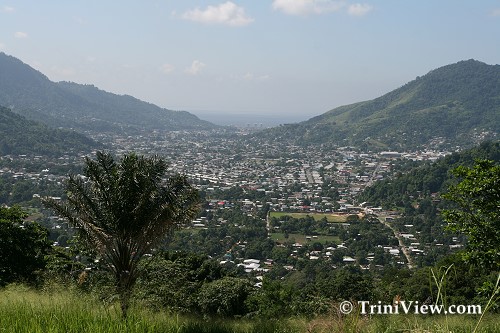 On North Post Hill, overlooking Diego Martin
On North Post Hill, overlooking Diego Martin
TriniView.com Reporters
Recorded: September 16, 2007
Posted: October 08, 2007
It was quite an adventure exploring the Diego Martin area located in northwest Trinidad. Triniview.com traveled there on the early morning of Sunday 16th September, 2007, via the Morne Cocoa Road from Maraval. The morning sun was warm and bright and the wind gave off a reminiscent chill from the cold night past. Our vehicle snaked its way around the smooth and freshly paved road of the carved mountainside viewing the deep valley below and the surrounding mountains on the left side of the road. Beneath blue skies and cushioned between green plants and shrubs were houses. Viewing them from the higher level looking down, we saw silvery-grey and rusty-red coloured galvanize rooftops; some stained with mossy formations atop wooden and concrete structures.
Along the way, we noticed plenty greenery despite the recently harsh dry season which left much of the country black and brown. Soon, we were at the base of the mountain and journeyed to the heart of the Diego Martin area via the St. Lucien Road. Bypassing fruit stalls, groceries and shops along the way, gave testimony to the increasing industrialization of the mainly residential area.
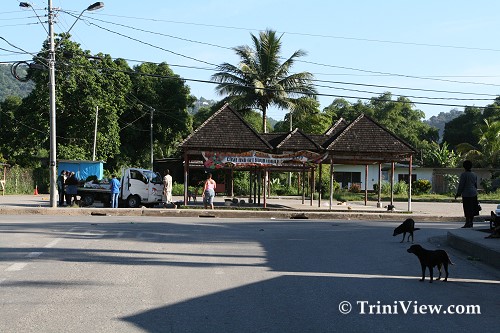 The Bus Terminus in Diego Martin
The Bus Terminus in Diego Martin
Finally, we arrived at the junction by the bus terminus which is the furthest that one can come to on the westward journey along the St. Lucien Road; but another road extends horizontally which runs through other areas within the Diego Martin village. We swung right in the direction of North Post Hill.
The North Post Hill area is one of the most spectacularly beautiful places in Trinidad and Tobago and its popularity has been increasing in recent times. On our way to the top, we visited North Post Hill resident, Trevor Onefa Daniel who was in the company of his two daughters, Gayle Daniel and Donna Paul. Mr. Daniel allowed us to roam his land and sample his many fruits such as his large variety of mangoes, plums and tasty coconuts, which a member of Triniview.com gladly assisted in picking.
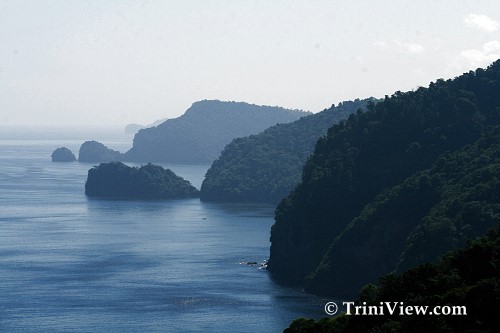 View from on top North Post Hill
View from on top North Post Hill
The panoramic view from his residence of the North Coast was absolutely awesome: the sun's rays were not yellow - they were golden; the sea was not just plain blue but had a silvery gloss that captured within its hold the richness of the still, glassy waters; the smooth, green grass skirted the fruit trees that stood tall and mighty, protecting all else that lived beneath them; and the islands in the distance were but a shadow of themselves, blackened by the glorious sun that stood behind them.
After witnessing breathtaking scenes about his yard, we briefly interviewed Mr. Daniel, a noted African drummer in the village, about his experiences in that regard. He outlined for us his inspiration for drumming and his life's journey that led him to that point.
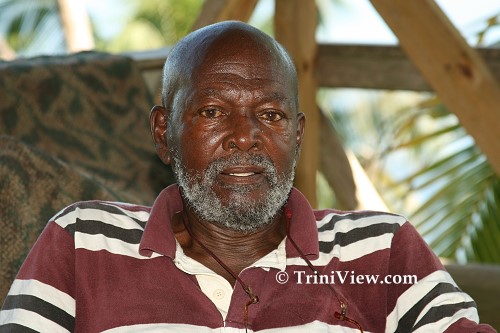 Trevor Onefa Daniel
Trevor Onefa Daniel
Before we trekked farther up the hill, we observed the built-up Diego Martin area from where we stood. Many houses seemingly crammed together looked like little boxes either lined in horizontal and vertical formation or, from another viewpoint, like concentric rings spreading from a center.
Journeying a bit further up the top we arrived at the tiptop of the North Post Hill where stood TSTT's Maritime Radio Station. There was a hut for visitors, a teak plantation further inside the area and another fantastic view of the North Coast.
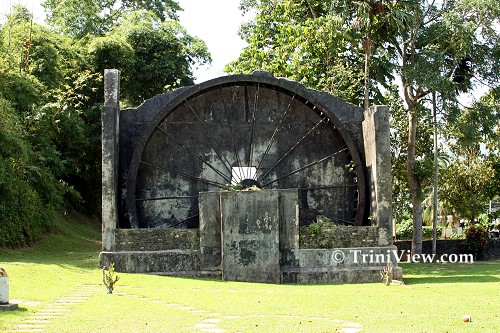 The old Water Wheel
The old Water Wheel
After leaving North Post Hill, we visited the River Estate Museum and Water-Wheel sites located at the River Estate Historical Park, which are places of historic interest and value in Diego Martin. The old wheel, which was once vital to the Diego Martin community and the sugarcane and cocoa plantations that once existed there, is now defunct and serves only as a memory of what once was. The Diego Martin area was once a booming and fertile agricultural region, but over the years, the number of farmers have decreased rapidly as the number of residents increased.
From there, we traveled to the popular Blue Basin Waterfall which lived up to its reputation as a tranquil, relaxing and beauteous hideaway. There are two main ways to enter the Blue Basin Waterfall from the Blue Basin road: either using the steep road provided or by following the path of the Dobla (D'eau Bleau) pool at the bottom. Triniview.com members decided that we would follow the river's path and journey upwards. We very much delighted in our decision and the adventures that we had along the way.
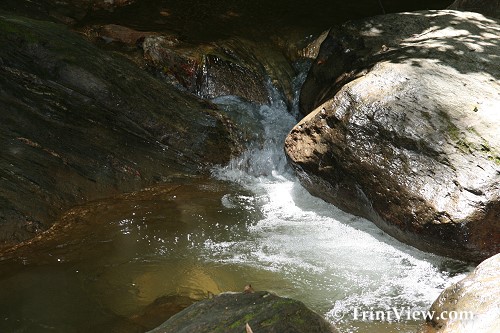 Blue Basin river
Blue Basin river
The river is often frequented by devotees of the Orisha and Spiritual Baptists faiths and we passed a shrine to the Orisha deity Ogun, who, symbolized by a cutlass, represents the "opener of the way". Around this shrine were flags, carvings and symbols representing various elements in the Orisha cosmology.
While we did observe some wild life, they buzzed by quickly or hid in burrows of leaves and earth in human presence. There were also large, mossy rocks that possessed some challenges in climbing but added to the natural aesthetic of the environment. We also crossed several large pools, gushing streams, jutting rocks and more mossy rocks and stones.
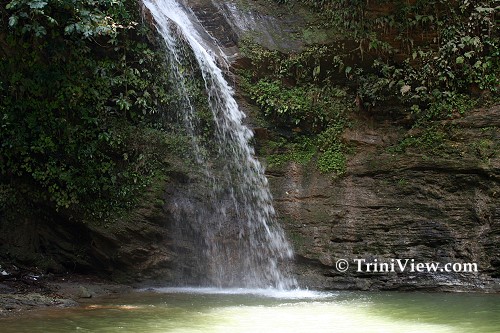 Blue Basin Waterfall
Blue Basin Waterfall
Finally, we arrived at the Blue Basin Waterfall. The water in the pool was deep and green, replenished continually by the cascading flow of water falling several meters down into the pool. There, we met a group of friends liming by the waterfall, diving and swimming in the water. Enviable were the peaceful and cheerful looks on their faces as the cool waters seemed to therapeutically rid them of external stresses.
The last stop in our rendezvous to Diego Martin was at the home of ninety-seven year old Leta Salandy. After meeting with two of her children, Faye and Alfred Salandy, we interviewed her about her life in Diego Martin through the years. She explained much about the area and the activities that she engaged in as a child and as an adult there.
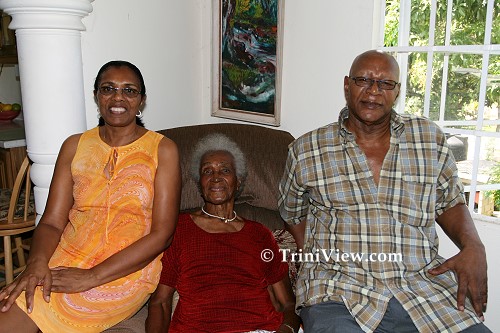 Ma Leta Salandy with daughter and son: Faye and Alfred
Ma Leta Salandy with daughter and son: Faye and Alfred
After our chat, we headed outside to take a look at her beautiful garden adorned with a myriad of flowers and plants, fruits which bordered her home.
Visiting that part of the Diego Martin area proved that there are areas in Trinidad and Tobago that are still rich in natural beauty and history but it also reminded us of the fast processes of industrialization and the possibility that much of this beauty could be soon lost. It also opened our eyes about how large Diego Martin is and how much of it there is to be explored.
Diego Martin: North Post, Water Wheel and Blue Basin in pictures:
www.triniview.com/gallery/main.php?g2_itemId=210689
Homepage | Special Events | Photo Gallery
|
|
